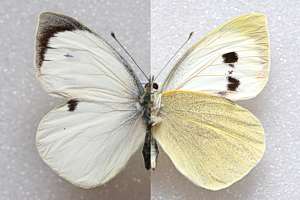Erstbeschreib
Description of a hitherto unnamed Butterfly from Madeira - Ann.Mag.Nat.Hist.(5)17:430.
Typenverbleib
Natural History Museum, London
Taxonomie
Die Erstbeschreibung lautet:
'Ganoris Wollastoni, sp.n. Intermediate between G. cheiranthi and nipalensis, differing from the former in its inferior size, paler and greener tint in both sexes, the female without distinctly yellow secondaries and with the black spots smaller and less distinctly confluent, the three median veins all blackened beyond the black spots. Under surface quite different from that of either species, the tint of secondaries and apex of primaries being greener even than in G. brassicae. From G. nipalensis it differs in having a black longitudinal dash on the second median interspace on the upper surface of the male, and the black spots in the female more or less united by a sinuated blackish streak from the inner margin; all three median branches blackened (whereas in G. nipalensis only the second and third are black); the secondaries below sulphur-yellow, densely irrorated with blackish scales, the costa and apical area of primaries pale sulphur-yellow; the black spots with two black dots between them. Expanse of wings, male 67 millim., female 72 millim. Madeira (T.V.Wollaston).'
BUTLER beschrieb das Taxon als eigene Art, deren Männchen einen Zellabschlussfleck tragen. Beiden sind die Flecke der Vorderflügel sowie der Innenrandmakel durch einen schwärzlichen Wisch verbunden. Die Hinterflügelunterseite ist grünlichgrau. Die Flügelzeichnung gleicht jener von P. cheiranthi cheiranthi, ist aber weniger ausgedehnt.
E. Reissinger (1990, l.c.) stellte wollastoni (BUTLER, 1886) zu Pieris cheiranthi. Die IUCN (International Union for Conservation of Nature and Natural Resources ) sowie weitere Autoren anderseits listen sie als eigenständige Art: Pieris wollastoni.
Pieris wollastoni stellt phänologisch eine Zwischenform zwischen Pieris brassicae und Pieris cheiranthi dar. WIEMERS (pers. Mitt.) konnte DNA-Bruchstücke eines Tiers von 1960 analysieren und fand, 'dass wollastoni mit cheiranthi näher verwandt ist als mit brassicae'.
Pieris wollastoni wurde seit etwa 1986 nicht mehr gefunden und gilt als vermutlich ausgestorben (IUCN: European Red List of Butterflies [www]. Der letzte mir bekannte, konkrete Nachweis ist vom 7.Mai 1977 (leg.Wolff).

 Madeira. Gilt seit 1986 als ausgestorben.
Madeira. Gilt seit 1986 als ausgestorben.
 Madeira, Ribeira Brava, 10. Mai 1976, e.l. MEYER-WESTFELD. Männchen.
Madeira, Ribeira Brava, 10. Mai 1976, e.l. MEYER-WESTFELD. Männchen.